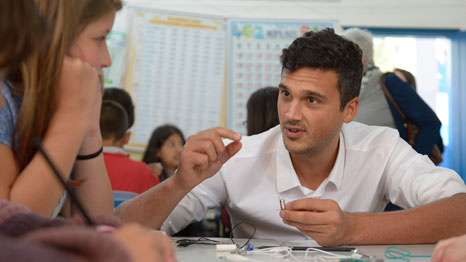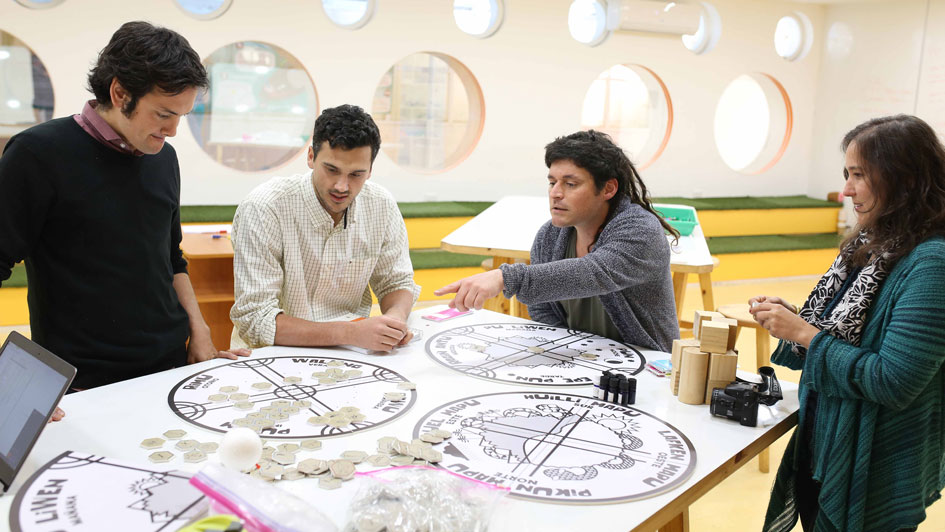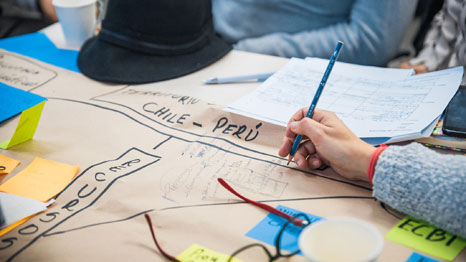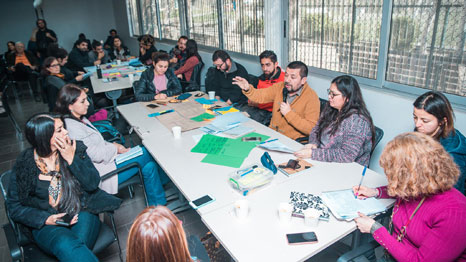
»The only way we can create change in the global education system is by working together with our international networks.«
Local actors – internationally networked
They pool knowledge and information while connecting people, initiatives, and organizations – the role of networks is increasingly important across the board. Siemens Stiftung’s concept of networks includes a variety of approaches, from digital education programs to organizing physical meetings between network stakeholders. Among these is the “International Dialogue on STEM Education (IDoS)” that takes place every two years. The congress brings together 100 international experts to discuss their work in early childhood education. Badin Borde explains in an interview how networks are formed and utilized at Siemens Stiftung.
Mr. Borde, for the past year, you’ve overseen international networks in Siemens Stiftung’s working area Education.
That’s correct. Networks are among the main focuses of our work at Siemens Stiftung. The only way we can create lasting change in the global education system is by working together with our international networks. However, networks are complex. From international to local stakeholders, each have their own interests, positions, and roles that must be recognized and incorporated into how the network operates.
And each Siemens Stiftung network is set up differently ...
In some cases, we create local stakeholder networks, such as the “STEAM Territories” in Latin America that cover the subjects of Science, Technology, Engineering, Arts, and Mathematics. But we also belong to national and international education networks, which involve partners such as “Haus der kleinen Forscher (Little Scientists’ House),” the Technical University of Munich, the Office for Climate Education (OCE), and UNESCO. I work as a go-between in these networks, operationally and strategically, by structuring and connecting networks at an international level. When individual experiences can be shared across the network, it is a greater impetus for everyone.
How effective are networks in the field of education?
Networks have several advantages: They can facilitate an exchange of ideas, such as the one that occurs at IDoS, an event we put on with Haus der kleinen Forscher. Stakeholders can learn from each other at the international level in a network like this. But connecting individual initiatives that successively expand on shared subject matters can also provide value. That speaks to the basic principles of education: Kindergarten, school, higher education, life-long learning – it is always about the successive collection of knowledge. Our work in the STEAM Territories is based on this principle. Beyond that, networks with a specific thematic focus, such as climate change or digitalization, are also important for us. We use these networks to collect resources on a particular subject. One example is our work with the Office for Climate Education (OCE).
You also work with the STEAM Territories in Latin America, tell us more about it.
Our STEAM Territories concept focuses on creating local networks with strategic and operative partners from civil society, the government, academia, and the private sector to bring about a collective impact on the local education system. STEAM Territories are stakeholder networks that implement education programs in STEAM. In Latin America, our efforts have already led to six STEAM Territories from Mexico to Chile. These are unique in terms of their size but also in terms of their thematic emphasis. Taking this territorial approach helps to define stakeholders and later bring them together in a particular field. Education innovations that spring from a specific local context are shared among other stakeholders at the local, national, and international level and adjusted to fit other situations. This is how our education program Experimento, the international STEM education program for hands-on science and technology lessons, has been implemented in the Territories.

Can you describe Siemens Stiftung’s approach to the STEAM Territories in a little more detail?
Siemens Stiftung acts as a bridge-builder to connect the various stakeholders in a region. STEAM Territories are defined through existing networks and an analysis of the territorial context. Next, we meet with potential stakeholders from the private sector, academia, city and regional administrations, and communities to listen to their ideas, expectations, and positions while considering the role they could adopt in a STEAM Territory. Finally, the stakeholders take part in workshops to establish goals and specific duties, meaning the education issues that are identified are pursued collectively. To sum it up, STEAM Territories act as incubators for education innovations.
What are some of the issues that are addressed?
Let’s take a look at the Chilean STEAM Territory Macro Zona Sur, which is focusing on education for sustainable development. Air and water pollution, and a threat to the endemic biodiversity meant a regional definition of goals and an allocation of responsibilities came together quickly. A course of study on education innovations for sustainable development has been offered for the first time thanks to the collaboration, and climate education and education for sustainable development have been also incorporated into the local curricula in the cities of Villarrica, Frutillar, and Pucón. As a foundation, we join academics as neutral, independent stakeholders and can build bridges between the public sector, private sector, and civil society.

This year, the International Dialogue on STEM Education (IDoS) is taking place for the second time. What is IDoS?
The congress was launched in 2017 by “Haus der kleinen Forscher” and Siemens Stiftung. As one of the founders of Haus der kleinen Forscher – a purely German initiative – we wanted IDoS to encourage international exchange, using our position as an internationally-active foundation to bring together experts from across the globe. One hundred STEM stakeholders from education, academia, the private sector, civil society, and the political sphere are meeting to share their experiences in early childhood STEM education. Some participants from the previous congress will be attending, but new stakeholders from the foundation’s network were also able to apply to take part.
What is the focus of the congress?
IDoS 2019 is taking place in Berlin on 5 and 6 December at the same time as the UN Climate Change Conference in Madrid. These two events are thematically linked. At IDoS, the emphasis will be on education for sustainable development: How can the Sustainable Development Goals be combined with the 21st century skills to create awareness about climate change, climate education, and action for climate empowerment in STEM lessons? A deeper understanding of these global phenomena begins with solid STEM education. The workshops are on a wide array of subjects, ranging from questions about how indigenous knowledge can be integrated into education, to design thinking approaches, developing education innovation, and even the political implementation of STEM initiatives. One specific example is a question that comes up in Kenya: how can the country incorporate sustainable development into the STEM education curriculum?
This year’s IDoS will produce a position paper for the first time – why is that?
The participants want to signal the commitment of all stakeholders to come together on a collective effort that is based on individual positions, scientific backing, and effective implementation. This is how we make sure everyone is on the same page and is prepared to move in the same direction at the same time. Putting this commitment into words strengthens the international ties of the network.
Alongside the network activities, climate change education is also a part of your work at Siemens Stiftung.
Climate change is an important issue, especially in STEM education. Thanks to my previous position, I am familiar with how scientific studies on climate change adaptation are implemented, and how projects aimed at increasing awareness of climate change are executed. Siemens Stiftung works with the Office for Climate Education on these issues. The OCE creates Open Educational Resources for climate change education, including teacher training seminars or teaching and learning materials. We can introduce these materials to our networks, which in turn make them available to even more multipliers.

What previous experience do you bring to the position of network coordinator at Siemens Stiftung?
I studied human geography in addition to city and regional development, so I am familiar with the different parties that are involved in city development processes. These stakeholders only come together as a network when everyone shares the same level of involvement. As an example, modern cities are very commercially-focused. This is a source of conflict, gentrification, and socio-physical segregation because the urban network was either not created with balance in mind or the balance has started to shift. A similar development cannot be allowed to take place in the education sector. Preventing this is one reason to create the STEAM Territories – they must always include all participants. In my work at Siemens Stiftung, I can take what I learned at university and combine it with my professional experience in academic and didactic design and implementation of educational materials. My German-Kurdish background is also quite useful in international work. Growing up in a bi-cultural family taught me intercultural competence and openness.
November 2019
Badin Borde
+49 89 540487 326


